naked body on the floor (there are no heroes in everyday tragedies)
critical review of amilton de azevedo about Milo Rau’s “The Repetition: Histoire(s) du Théâtre (I)”, presented in MITsp 2019 (São Paulo/Brasil).
It is the night of March 14th, 2019. One year ago, the brutal execution of Marielle Franco — that also took the life of her driver, Anderson Gomes — in Rio de Janeiro. Yesterday, the massacre in Raul Brasil state school took place in Suzano, when two former students killed eight people. In addition to violent murders with firearms, Brazil this year also saw the environmental crime in Brumadinho (with the rupture of a Vale’s dam, destroying the environment, cities and taking 206 lives) and the fire in Ninho do Urubu (Flamengo’s soccer team training centre, with the death of ten teenagers).
It is hard to go by an entire day without a bad news. Tragedies are happening on a daily basis; and we, in the middle of the vortex, so many times feel powerless, exhausted. Every time we are more astonished not only with the actions witnessed but with their intentions and motivations. And it is not something exclusively Brazilian.
About the same time that “The Repetition: Histoire(s) du Thêátre (I)”, from Swiss director Milo Rau, began its performance in Auditório Ibirapuera, an attack on two mosques in New Zealand, with forty nine victims. The shooter, amongst an extensive manifest published online, streamed the entire action in social media.
Considering the actual context of such violence, what stands out in most of the cases are, one way or another, the complete and absolute disregard for human life. The total absence of a view that recognizes a human being as such, considering his right to live as the most precious one.
In “The Repetition”, Rau and his collective, the International Institute of Political Murder (IIPM) starts off from a violent crime from our times to create tension between limits and possibilities of representation in the theatrical act, frictioning it with data and facts from reality. For such, actors and non-actors are used in the reconstruction, under several optics, of the murder of Ihsane Jarfi.
In the year 2012, in Liège, Belgium, the young Belgian — with Moroccan origin — homosexual was last seen getting in a car with four men when leaving a party. After that, he was tortured and murdered by them. His body was found ten days later — with marks of a violent death. By 2014, three of the murderers were convicted to life sentences for murder with homophobic motivations — the fourth occupant of the car got 30 years for manslaughter with homophobic motivations.
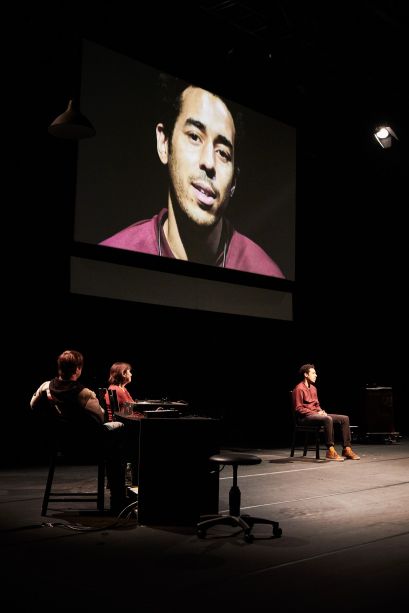
In order to tell this story, Rau’s staging makes use of a series of resources. The narrative of the case itself is divided in five acts — such choice can suggest a dialogue of the form of tragedies, playing with the so-called origin of western theatre while questioning its limits; in Wislawa Szymborska’s poem recited, such intention seems to be explicit. However, before that comes the cast selection for the work’s process.
At the very beginning, an actor (Sabri Saad el Hamus) introduces a possibility of what would be theatre for him. The representation, the concrete dealing with the character. His propositions, as many other images being proposed in this prologue, are like baits thrown at the play’s development — elements that will stay suspended until referred to or resignified. Right at the moment of the interviews, Suzy Cocco, Fabian Leenders and Tom Adjibi seems to reverberate an el Hamus’ comment, who had just criticized what would be actors “playing actors” when “getting into” the role while backstage or in the dressing rooms.
What is being proposed there is that Cocco, Leenders and Adjibi represent their own audition to be cast for the play. Also in this moment, the introduction of a camera, that allows the audience to see details of each one’s expressiveness, starts to create possible cut-outs for reading through the representation layers. Besides that, a metatheatrical game starts to put habitual ways of looking at our relation with theatre at stake.
There are, in each one’s speech, explicit or subtly, harsh criticism towards social norms and the fact that such normatizations are seen when working in theatre. As if diversity, instead of potentializing creation, would curtail the possibilities of each one to a niche, conformed and within expectations.
Next, the five acts of Jarfi’s tragedy are drawn, each one under a different aspect of what happened. In the “solitude of the living”, one of the most beautiful image composition of the work overlaps and friction times, spaces and medias. The empty bed, the video and the actors onstage; in three possible scenarios, the parents facing the non-return of a son. Cocco, with a as heart touching as subtle interpretation, appears to make present the pain of that mother
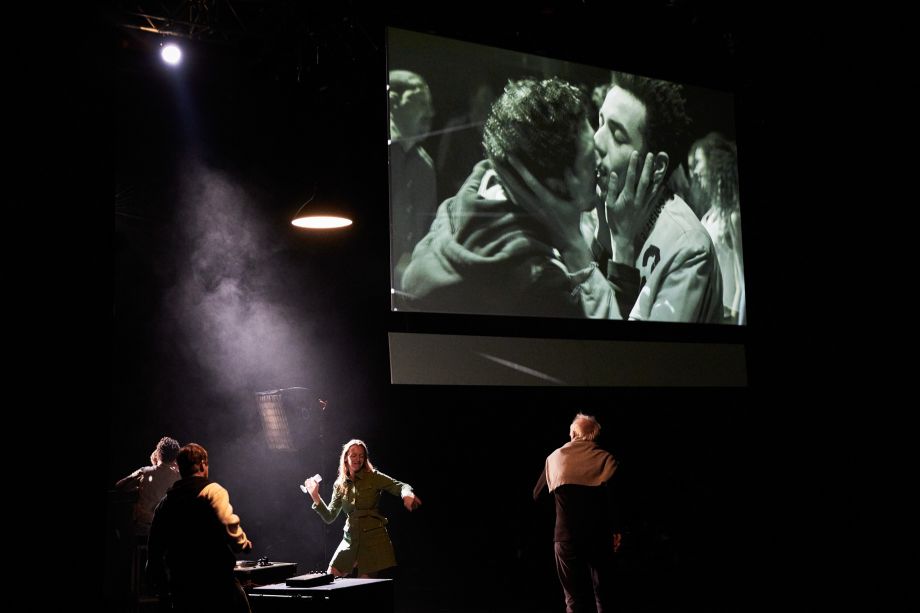
In “The pain of the others”, the trial brought to question evidence, on the one hand, the performative processual element in Sébastien Foucault proposition of attending personally the audiences — opposing the intimate theatricality present in his narration and representations. On the other hand, again in dialogue of the tragedy, the absurd of what is discussed: when revolving around what would have been said by Jarfi, what seems to be in debate is that whether hybris was present — a possible excess of his part.
There are no such excess that justifies a beating that lasted, according to the legist analysis, between four and six hours. And yet, it was part of the case. Here, the beautiful and simple history narrated in the prologue, where a youngster claimed to like to talk to dead people because, even though they can’t answer, at least they listen., makes us think that it would be better if they couldn’t. Also in the second act it is put in question the use of Jarfi’s dead body during the trial — and his familiars way of coping with it.
In the “banality of evil”, Leenders reports his encounters with one of the murderers, Jeremy Wintgens. While transiting between narrating and representing Wintgens, the Hannah Arendt’s concept that gives name to the chapter seems to haunt him in the perception that he, the interpreter, could be, in real life, the interpreted.
The entire trajectory of the staging seems to present and develop procedures that will, in a certain way, reach its apex in the fourth chapter — “The anatomy of the crime”. The representation of the traumatic and irrepresentable real problematic — in this case, the actions that lead to Jarfi’s death — is assumed by assuming an almost hyper-realistic use of illusion. Rau chose not to use a resource already seen in the play — the simultaneous action onstage dialoguing with recorded video. The scene makes a keen use of the camera, but it is the fact that is happening at the stage that makes it even more powerful. It is less representation and more reenactment.
When deciding to put the events in the stage in the most concrete way possible within the representation limits — and creating tension within theatrical conventions — “The Repetition” becomes an extremely aggressive work. If the narrative and symbolical violence was present before, now it catches the eye of the spectator. The car, the rain, and the naked body on the floor: all that is left is consternation and pain. Rau and his collective don’t want to offer deepest answers to the events; it is only about expliciting the banality of the act. And the complete helplessness of Jarfi.
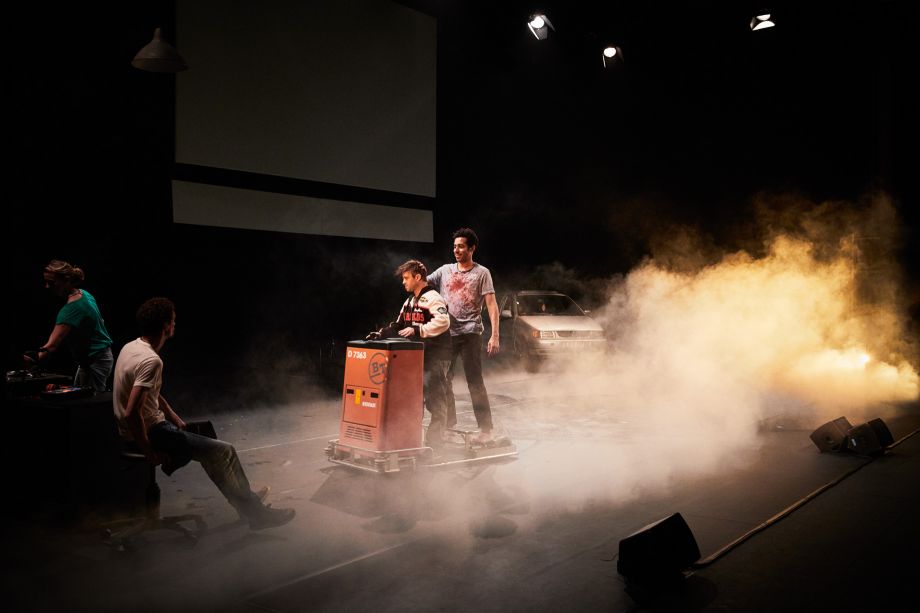
The last chapter — “The bunny” — brings Sara De Bosschere as Jarfi’s ex-boyfriend that, somehow, searches for signs that would show how to keep living. And the way that “The Repetition” heads for its end seems to propose the clash between life and art — or, between real and representation. In Szymborska’s poem, almost an ode to closing curtains. The beauty of the theatrical act even when dealing with the most tragic elements of the world.
And it is only in the final scene that the reasoning of the play is effective as a whole. The — so-very old — possibility of transformation that theatre have is configured. The real, when reminded, is undoubtedly fixed; facts and its material documents are already there. By allowing Adjibi to surprises us, making him not someone who is in the play only because physically resembles Jarfi, Milo Rau’s staging seems to believe in the potential that lies on theatre capacity of constantly creating ruptures in order to make movements within us.
The norm is, then, transcended. The victims of daily tragedies are not heroes being punished for confronting them. Throughout memories, theatre allows us to look in perspective towards our stories, who we are and what we make of them. And, inevitably, if the audience of the world doesn’t take action, the actor dies.
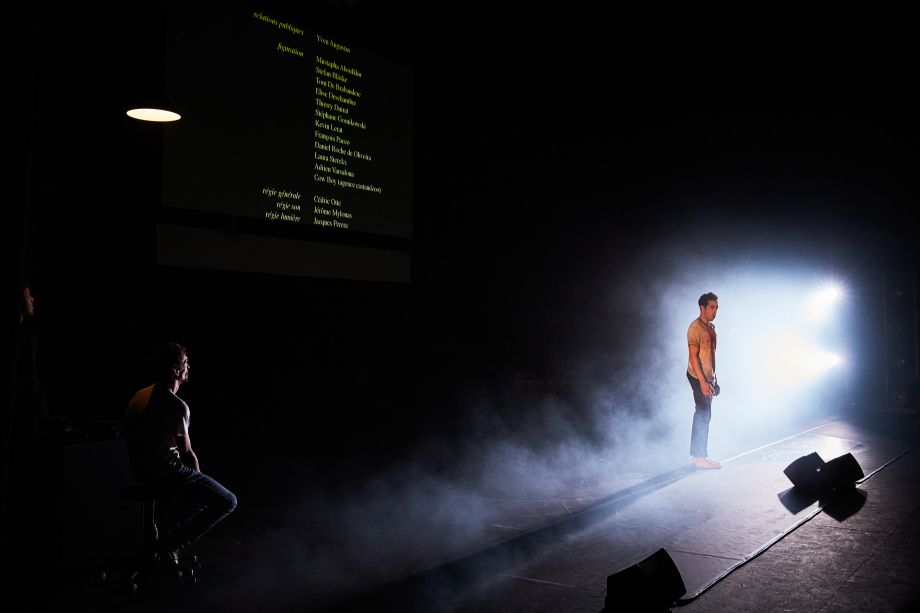

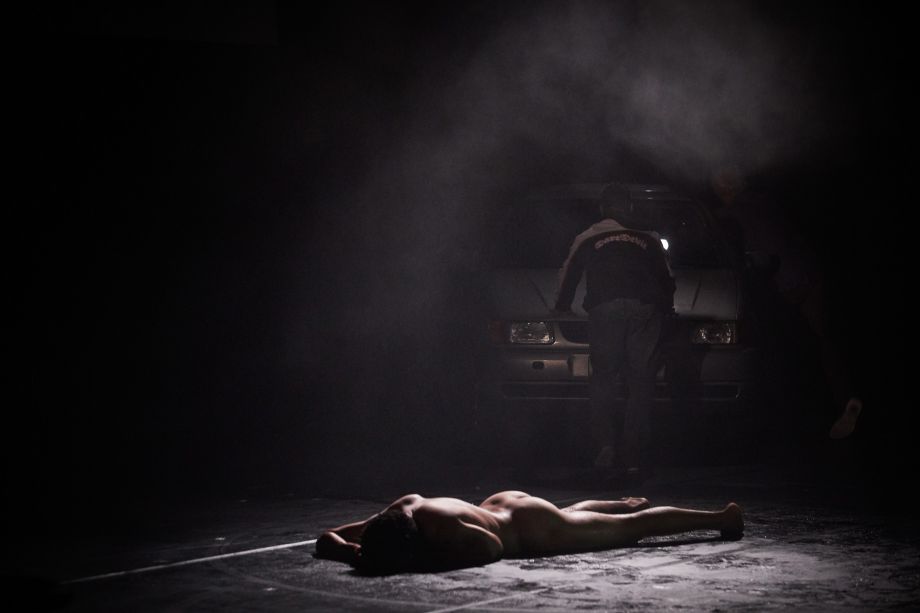
um comentário em “naked body on the floor (there are no heroes in everyday tragedies)”